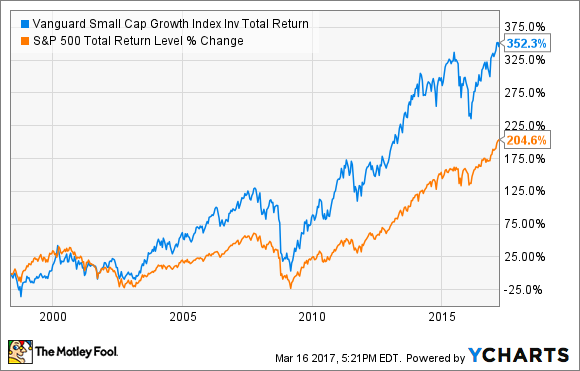Editor's note: This article was updated on March 16, 2017.
It's been a very "up and down" 2016 for investors. And since the election of Donald Trump as the next president, both optimism and uncertainty are affecting the market in the short-term. But whether you're 25 or 55, you need to consider your needs beyond this year, and stocks remain one of the best ways to grow wealth.
For many of us, index funds are an ideal way to invest in stocks. Not only are there lots of low-cost choices tailored to different investing needs, but index funds are great for people who don't have the time or patience to pick individual stocks.
With that in mind, here's a look at some of the best index funds to buy in 2016. While it's impossible to know what the short-term will bring come year-end, 2016 is still a buyer's market for investors looking at the bigger picture.

Index funds can be a wonderful part of any portfolio. Source: Getty Images.
The best index fund for most investors
Over the past century, the stock market has averaged about 10% in compounded annual returns. There have been years with much lower and much higher returns, but when averaged out over decades, getting a 10% rate of return has held up relatively well. With that in mind, one of the best index funds out there is the Vanguard 500 Index Fund (VOO +0.76%). This fund tracks the S&P 500, and is consistently the lowest-cost way to do so with an expense ratio of 0.05% (that's 5 cents for every $100 you invest in the fund). Since this is an ETF you'll pay trading commissions, so it's important to consider that if you plan to invest regularly.
You can also invest in this fund through Vanguard's mutual fund shares as the Vanguard 500 Index Fund Investor Class (VFINX 0.23%) and Vanguard 500 Index Fund Admiral Class (VFIAX 0.23%). The admiral class shares charge the same 0.05% expense ratio as the ETF, but there is no transaction fee to buy shares. Investor class shares charge a higher expense ratio of 0.17% (17 cents for every $100 invested), but require only a $3,000 minimum investment, while the admiral shares require a $10,000 minimum investment.
In other words, it's important to pick the proper share class for this index fund based on how much you'll invest both up front, and how often you plan to buy more shares to keep your fees as low as possible. At any rate, you can expect to capture these kinds of market-average returns with this low-cost index fund:
VFINX Total Return Price data by YCharts.
Looking for a little more growth?
An index fund that tracks the S&P 500 is a great foundation for most investors, but there's some evidence that small cap stocks can provide even better returns. With this in mind, Vanguard Small-Cap Growth ETF (VBK +0.86%), which is also available as Vanguard Small-Cap Growth Index Fund Admiral Shares (VSGAX 0.36%) and Vanguard Small Capitalization Growth Index Fund Investor Shares (VISGX 0.35%), is worth consideration.
The catch? You have to be willing to ride out higher volatility:
VISGX Total Return Price data by YCharts.
Since inception, the Vanguard Small Cap Growth Index Fund has handily outperformed the market, but it's also fallen much more sharply over short periods of time. For example, since the beginning of 2015, the fund has underperformed the S&P 500. As you can see below, it also tends to fall more sharply than the broader market when the market declines as it did to start 2016:
VISGX Total Return Price data by YCharts
In other words, the potential returns over the long term come at the cost of more short-term price volatility. If you're working a shorter window of investing time, this fund may increase your risk of losses, and might not be the right fit.
Income and capital preservation? A utility index fund may be best
Two index funds that come to mind if you're looking for to preserve capital, while counting on some income, are the Vanguard Utilities ETF (VPU +1.04%), and Guggenheim S&P 500 Equal Weight Utilities ETF (RYU +0.75%). Both of these index funds include traditional electric, gas, and water utilities, while the Guggenheim index fund also includes the S&P 500 components of the telecom sector as well.
Neither of these funds is going to reward you with the kind of price appreciation of the growth index fund or even the S&P 500 index fund discussed above, but they also tend to fall less when the market declines. As you can see in the chart below, these two utility index funds tended to increase in value when the market declined sharply, though their returns since the beginning of 2015 has trailed the market:
RYU Total Return Price data by YCharts.
Furthermore, there's some risk that rising interest rates could further affect utilities which rely heavily on debt to fund capital expansion, so don't consider these to be risk-free investments.
But if you're looking to invest for a few years, not a few decades, but would like some income and lower risk of capital losses, the nearly 3% dividend yield of these funds at recent prices, and the stable holdings that most utilities offer, make these two index funds worth considering.
Looking ahead
Nobody knows what the stock market will do over the short-term. However, investing in low-cost, high-quality index funds should lead to solid returns over the long-term.
Whether you're looking for the foundation of your portfolio, great long-term growth potential, or stability and income, there's a good chance one of the index funds above is right for you.









